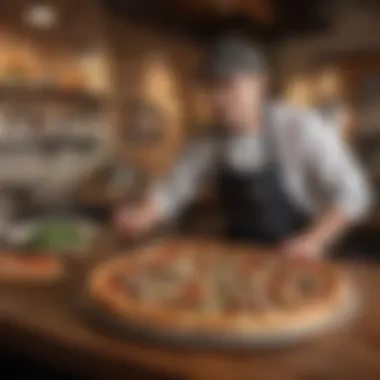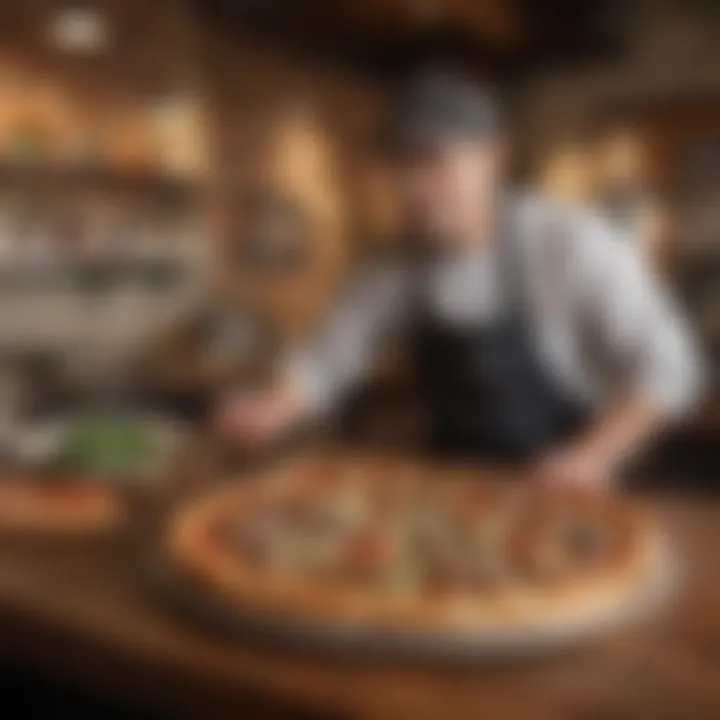Exploring Chicago's Vibrant Culinary Diversity


Intro
Chicago's culinary landscape is a tapestry woven with diverse cultural influences and historical significance. This city does not simply serve food; it creates a narrative through its culinary offerings. Each dish tells a story of its origins, showcasing the different communities that have found a home within this bustling metropolis. From the rich flavors of Mexican cuisine to the simple elegance of Italian trattorias, Chicago is a place where food becomes both an art form and a means of connection.
An exploration of Chicago's gastronomy reveals an intricate web of restaurants, food trucks, and markets that cater to a wide array of palates. In this article, we will journey through various districts, highlighting notable eateries, local favorites, and some lesser-known gems that may just surprise you. This will not only serve as a guide for food enthusiasts but also as inspiration for home cooks eager to experiment with their culinary creations.
Food trends and dining styles are constantly evolving in this vibrant city. The interplay of tradition and innovation creates a dynamic food scene, rich with opportunities for exploration. Major culinary events throughout the year gather community members, chefs, and food lovers, fostering an environment of creativity and collaboration.
By detailing the food experiences that Chicago offers, this article aspires to ignite a passion for its diverse dishes among food lovers of all ages. Whether you're a seasoned gourmet or a curious novice, the array of flavors and experiences in Chicago's dining scene is sure to provide something for everyone.
Preface to Chicago's Culinary Identity
Chicago possesses an extraordinary culinary identity marked by its vast diversity and rich cultural influences. This unique identity is vital to understanding the city’s food landscape as it encapsulates various traditions, flavors, and cooking techniques brought in by different communities. Here, food serves as more than just sustenance; it represents a tapestry of connections crafted over decades.
The city’s cuisine reflects its history. Ethnic neighborhoods thrive with vibrant eateries, each telling a story through their dishes. Italian, Mexican, Polish, and Indian food, among others, populate the landscape. Understanding the culinary identity allows us to appreciate how these cultures have influenced local eating habits, contributing to a dynamic food environment.
Food lovers of all ages can benefit from delving into Chicago’s culinary identity. For residents, it fosters a sense of community and belonging. For visitors, it enhances their experience, allowing them to savor authentic and diverse flavors.
A key element of Chicago’s culinary identity is the fusion of traditional recipes with contemporary techniques. This blend keeps the food scene innovative while remaining respectful of its roots. Exploring this identity encourages one to recognize the importance of supporting local businesses and engaging with the multicultural fabric that defines Chicago’s gastronomy.
"Culinary identity is not just about the food on the plate; it is about the experiences and stories shaping that plate."
This intricate exploration of Chicago’s culinary landscape highlights how each bite is a reflection of the city's history and cultural evolution. The conversation shouldn't just stop at the food. It extends to include awareness of how flavors, cultural practices, and food production impact our society as a whole. Understanding this identity supports not just local chefs and restaurants but also local farmers and artisanal producers, creating a comprehensive food culture that benefits everyone involved.
Historical Influence on Chicago Cuisine
The historical influences on Chicago cuisine are pivotal in understanding the city’s multifaceted food culture. Chicago's gastronomic identity is a product of its intricate past, shaped by migrations, regional traditions, and historical events. This section highlights how various periods and demographic shifts have helped define the current culinary trends.
Cultural Melting Pot
Chicago prides itself on being a cultural melting pot, where culinary traditions from around the globe converge. Waves of immigrants have settled in the city over the decades, each bringing their unique flavors and cooking techniques. This exchange of cultural practices has led to a vibrant food scene, where traditional recipes blend and evolve.
Cities often reflect the cultures that inhabit them, and Chicago is no exception. German, Polish, Italian, Mexican, and a multitude of other influences can be tasted across the city. Food is not just sustenance; it is a medium through which immigrants express their heritage. This has resulted in a dynamic environment where food plays a central role in fostering community and cultural understanding.
"Cuisine acts as a mirror, reflecting the history and diversity of a city."
Legacy of Immigrant Communities
The legacy of immigrant communities is perhaps the most significant component in the narrative of Chicago's culinary landscape. As new groups arrived, they established food markets, bakeries, and restaurants that catered to Chicagoans and maintained their culinary traditions. Over time, these establishments became a part of the communal fabric.
For example, the Italian community introduced iconic items such as pizza and pasta. The Mexican population contributed the beloved taco and enchiladas. On the other hand, the Polish brought pierogi and deli items, while the Chinese community integrated stir-fries and dumplings into local dining culture.
Chicago's food scene is representative of its residents — constantly evolving, adapting, yet cherishing its roots.
The cuisines are often celebrated during cultural festivals, where local residents gather to experience and embrace the flavors of different traditions. Furthermore, stories of these communities are illustrated, not only through food but also through drinks and traditions that accompany the dining experience.
These contributions have solidified Chicago's reputation as a hub for diverse and multicultural foods. In essence, the historical influences have created a rich tapestry of flavors that continues to evolve, shaping the dining choices available today.
Iconic Chicago Food Staples
The culinary identity of Chicago is deeply entrenched in its iconic food staples. This article emphasizes how these dishes not only reflect the city's rich history but also serve as a point of pride for locals and visitors alike. As Chicago evolves, these staples stand firm, offering a taste of tradition and a sense of community.
Dishes like deep-dish pizza, Chicago-style hot dogs, and Italian beef sandwiches exemplify the local flavor and are essential for anyone looking to understand Chicago’s food culture. Here, unique preparation methods, the origins of key ingredients, and the contexts in which these foods are often enjoyed come together to create an authentic experience. Knowing these staples may influence decisions on where to eat while exploring the city.
Unique aspects of these foods include:
- Cultural significance
- Method of preparation
- Local variations from neighborhood to neighborhood
Understanding these staples provides a meaningful context for any food enthusiast.
Deep-Dish Pizza
Deep-dish pizza is likely the most famous dish associated with Chicago. Its popularity continues to grow, drawing attention from pizza lovers worldwide. Characterized by its thick crust, this pizza is baked in a deep pan, allowing for a hearty layer of cheese, tomatoes, and various toppings.


The layering process is deliberate. First, cheese is placed directly on the crust before adding other toppings. This method creates a barrier that prevents the crust from becoming soggy during baking. The result is a rich, satisfying dish that offers a unique tasting experience.
Local pizzerias each put their twist on this classic. For instance, pizzerias like Lou Malnati's and Giordano's have developed their signature styles.
Chicago-Style Hot Dogs
The Chicago-style hot dog is an iconic street food that many consider a must-try. What sets it apart is its combination of toppings, which include yellow mustard, chopped onions, neon green relish, tomato slices, a dill pickle spear, and sport peppers, all served on a poppy seed bun.
One key rule is that it is never served with ketchup. This aversion to ketchup stems from a desire to keep the flavor profile balanced and distinct. Historians suggest that this hot dog emerged during the Great Depression, signifying affordability and accessibility.
Vendors around the city, such as Portillo's, are known for their authentic Chicago-style hot dogs, which capture the essence of this city's food culture.
Italian Beef Sandwiches
Italian beef sandwiches are another staple that showcases Chicago's unique culinary landscape. This sandwich consists of thinly sliced, seasoned roast beef served on an Italian roll. It can be ordered "wet" or "dry" depending on how much of the flavorful juice is added.
The origins of the Italian beef can be traced to the Italian immigrant communities in Chicago. These communities would often utilize cheaper cuts of beef, slowly cooking them to achieve tenderness and infusing them with a robust flavor.
Many establishments, like Al's Beef, have become synonymous with this sandwich, attracting both locals and tourists. The sandwich often comes with hot or sweet peppers, enhancing its taste and providing a delightful contrast to the savory beef.
Areas to Discover Chicago's Food Scene
Chicago's food scene is as varied as its neighborhoods. Each area offers distinct culinary expressions that reflect its history and cultural backdrop. Discovering these neighborhoods is vital for anyone eager to understand the city's culinary landscape. Each district brings something unique, whether it is buzzing eateries or quiet local spots. The vibrant food markets and restaurants represent not just the ingredients but the ethos of Chicagoans themselves.
River North
River North is a focal point for those seeking a mix of modern dining and artistic ambiance. This area is renowned for stylish restaurants and sophisticated lounges. Here, culinary enthusiasts can find everything from upscale dining establishments to casual eateries. Unquestionably, it is home to some of the most renowned eateries in Chicago. Notable spots like RPM Italian and Girl & the Goat stand out for their innovative menus and commitment to quality.
River North also attracts an artistic crowd with its numerous galleries and public art installations. Dining is not merely about food; it is also an experience that engages all senses. The area hosts various food festivals that celebrate local chefs and artisans.
Visiting River North provides insight into the modern culinary trends that resonate with both locals and tourists. It emphasizes collaboration among chefs and artisans, making it an essential area to explore.
Wicker Park
Wicker Park is celebrated for its eclectic vibe and rich culinary diversity. This neighborhood is known for artistic creativity and innovation in dining. Wicker Park showcases everything from gourmet donut shops to artisanal coffee houses, making it an intriguing place for food explorers. Restaurants such as Big Star and Biju’s Little Curry Shop highlight the variety of cuisines available.
Local markets and food events frequently occur here. They reflect the community’s encouragement toward independent vendors and sustainable practices. Checking out pop-up dining experiences can be rewarding. These often feature local chefs experimenting with new ideas and ingredients.
Wicker Park embraces a sense of community, where food contributes to social connections. This environment encourages experimentation in local dishes, merging many influences while respecting traditions.
Pilsen
Pilsen is an emblem of Chicago’s rich Hispanic heritage. The neighborhood is known for authentic Mexican cuisine, showcasing flavors that captivate the palate. It's not just about dining; it is about embracing a culture deeply tied to its food. Establishments like Birrieria Zaragoza and Nuevo Leon serve traditional dishes that have become staples.
Why Pilsen matters extends beyond its food offerings. The neighborhood is vital for art and culture. Street murals adorn many buildings, echoing the vibrant history of its residents. Food festivals, such as the Pilsen Food Truck Festival, are essential for experiencing local flavors.
Pilsen invites food lovers to engage with its cultural legacy. There is a palpable connection between the cuisine and the community here. Each dish tells a story and represents the identity of those who live in Pilsen.
Chicago's neighborhoods each tell a different story through their flavors and culinary experiences. Food is a thread that weaves these communities together.
In summary, the areas of River North, Wicker Park, and Pilsen offer diverse and meaningful dining experiences. By exploring these neighborhoods, visitors can gain a deeper understanding of Chicago's culinary identity.
Notable Restaurants to Experience
The culinary identity of Chicago extends beyond its rich history and diverse food landscape. When examining Chicago's food scene, notable restaurants play a critical role. These establishments reflect local culture, the influence of immigrant communities, and evolving dining experiences. Each restaurant brings something unique to the table, revealing not just flavors but also stories and creativity.
The importance of notable restaurants lies in their ability to showcase the city’s gastronomic diversity. They are often the first point of contact for visitors and locals alike, anchoring various neighborhoods and attracting food lovers from all over. From fine dining to casual eateries, these places often serve as cultural touchstones that help define Chicago's food character.
Fine Dining Establishments
Fine dining in Chicago offers a range of culinary adventures. Establishments are not just focused on food; they also emphasize service and atmosphere. Restaurants like Alinea and Kate's Kitchen are recognized for their innovative dishes and commitment to craftsmanship. Dining at these locations can be a multi-sensory experience where every element, from the presentation to the ambiance, matters.
"Chicago’s fine dining scene is as diverse as its people, providing something for every palate."


Patrons often expect a high level of sophistication. Chefs at these venues frequently use local ingredients, elevating traditional Italian or American fare while incorporating global influences. The opportunity to enjoy a meal prepared by a highly skilled chef can elevate one’s appreciation of food.
Casual Eateries
In contrast to fine dining, casual eateries offer comfort and accessibility. Locations like Portillo’s and Pequod’s Pizza showcase staples that residents crave. These places often embody a sense of community and have longstanding reputations.
Casual eating allows for a more laid-back experience. It invites visitors to explore local flavors without the exclusivity often found in formal settings. Many of these eateries are family-owned, contributing to the rich tapestry of Chicago's neighborhoods. This food experience also emphasizes how dining can be a communal activity, with gatherings over pizza or sandwiches being a part of everyday life.
Food Trucks and Street Food
Street food in Chicago represents an entirely different aspect of its culinary scene. Food trucks and pop-up stalls provide quick, affordable meals that cater to a fast-paced lifestyle. They frequently serve ethnic dishes, giving taste of global cultures through a local lens. Vendors like La Juanita or the BopNGrill have gained popularity for their inventive offerings.
Street food also signifies the city’s love for creativity. Food trucks are often experimental, allowing chefs to experiment without the constraints of a full restaurant. This diversity of offerings can be seen at events or local gatherings where the vibrancy of Chicago's food culture truly shines.
In summary, whether dining in a fine dining establishment or grabbing a quick bite from a food truck, notable restaurants in Chicago bring together the best of culinary art and community. They serve to enrich not only the palette but also the cultural narrative of this vibrant city.
Cultural Food Festivals and Events
Cultural food festivals and events play a pivotal role in Chicago's culinary landscape. They serve not only as a celebration of diverse cuisines but also as a gathering point for the community. These occasions provide a platform for local chefs, food enthusiasts, and cultural groups to showcase their heritage through culinary artistry. The importance of such festivals is multifaceted, encompassing cultural exchange, economic support for local businesses, and an avenue for experimentation and innovation in cuisine.
One significant benefit of these events is the opportunity for attendees to experience a broad spectrum of flavors and dishes that might not be readily accessible in everyday restaurant settings. Visitors can indulge in everything from traditional recipes to modern interpretations, often prepared by passionate chefs who bring their family traditions and stories into their cooking.
Chicago Gourmet
Chicago Gourmet is one of the premier food festivals in the city. Held annually, it attracts renowned chefs and foodies alike to indulge in an extravagant celebration of culinary excellence. The festival includes prominent tastings, cooking demonstrations, and educational panels, offering insights into the art of cooking and food preparation. Participating chefs present their culinary creations, often highlighting local ingredients and innovative cooking techniques.
This event stands out not only for its food but also for its commitment to raising awareness about sustainable practices in the culinary world. Through its programming, Chicago Gourmet emphasizes the importance of farm-to-table principles and responsible sourcing. This focus aligns with a growing trend towards sustainable gastronomy, reflecting the city’s commitment to environmental stewardship.
Pilsen Food Truck Festival
The Pilsen Food Truck Festival is a vibrant celebration that reflects the community's rich cultural tapestry. This festival showcases a variety of food trucks offering an array of dishes, ranging from classic Mexican street food to fusion cuisine that represents the neighborhood's diverse demographic. It provides an informal atmosphere that encourages exploration and discovery of new tastes.
An important aspect of the Pilsen Food Truck Festival is its support for local vendors. Many small, family-owned businesses take part, giving them a platform to reach new customers without the overhead of a brick-and-mortar establishment. Additionally, live music and artistic performances complement the culinary offerings, creating a festive environment that draws people from all walks of life. Through this festival, the Pilsen community fosters a spirit of collaboration and creativity, solidifying its reputation as a culinary destination.
Exploring Ethnic Cuisines in Chicago
Ethnic cuisines are a critical element of Chicago's diverse food landscape. The city’s culinary identity is shaped by its immigrant history and the flourishing communities that bring different traditions to the forefront. Each dish tells a story of cultural heritage, adaptation, and innovation. Exploring these cuisines allows one to appreciate not just the flavors but also the histories and experiences of the people behind them. For food lovers, this exploration acts as an introduction to the global tapestry that Chicago embodies.
Mexican Flavors
Mexican cuisine holds a significant place in Chicago's food environment. This influence can be seen in various neighborhoods, especially Pilsen and Little Village, which are vibrant hubs for Mexican food. Tacos, tamales, and enchiladas are just the tip of the iceberg. Many restaurants emphasize using fresh ingredients and traditional techniques.
Street vendors often sell authentic snacks like elote and churros, adding to the lively atmosphere. For those looking to experience Mexican culture, Dia de los Muertos celebrations and street festivals offer food that goes beyond the plate, weaving in tradition and festivity. Not to mention, taquerías such as Carnitas Uruapan and Birrieria Zaragoza consistently receive praise for their authentic offerings.
Indian and Pakistani Offerings
Indian and Pakistani cuisines give Chicago a rich palette of flavors. Neighborhoods such as Devon Avenue have numerous establishments that celebrate these culinary traditions. From biryani to butter chicken, the dishes are marked by their use of spices and fragrant rice. Naan and parathas are staple breads that accompany most meals, enhancing the dining experience.
Restaurants, like Gaylord India Restaurant and Tandoor Char House, provide not just food but cultural experiences through their ambiance and services. Many places host events that celebrate cultural festivals, making them popular spots for food enthusiasts looking to connect with the community. Indian sweets and chaats add a unique touch that continues to attract a diverse audience.
Asian Culinary Influences
The Asian culinary presence in Chicago adds even more depth to its food scene. With influences from countries such as Thailand, Vietnam, China, and Japan, diners can explore an array of flavors. Sushi bars like Sushi Namba offer fresh selections, while Vietnamese spots such as Pho 888 are known for their flavorful broths and fresh ingredients.
Hot pot restaurants, including HaiDiLao, have also gained popularity, providing an engaging dining experience that encourages communal eating. Asian cuisines not only showcase diverse flavors but also emphasize unique cooking techniques and presentations. As global awareness grows, awareness for these culinary expressions has expanded, drawing food lovers from all backgrounds.
"Chicago’s cultural richness is echoed in its food, making it a vital spot for culinary exploration."
By exploring these ethnic cuisines, one gains insight into the diverse influences that have shaped Chicago’s culinary scene. This blend of traditions continues to evolve, offering new experiences for both locals and visitors. Enthusiasm for cooking styles, techniques, and flavors contributes to an ever-changing gastronomic landscape that keeps Chicago vibrant.
The Impact of the Modern Food Movement


The modern food movement has dramatically reshaped Chicago’s culinary identity. This movement emphasizes fresh, local ingredients and a mindful approach to food consumption. Analyzing its significance reveals various elements that have cultivated a richer dining experience. This is critical for understanding current trends in Chicago’s diverse food landscape.
One important aspect is the farm-to-table concept. This method prioritizes relationships between local farmers and chefs, bringing seasonal produce into restaurants. By sourcing ingredients nearby, chefs not only support local economies but also ensure high-quality dishes that change with the seasons. This practice connects diners with the origins of their food, fostering a deeper appreciation for sustainable practices.
Farm-to-Table Concepts
Farm-to-table has gained traction as consumers become more discerning about the source of their food. In Chicago, many restaurants have adopted this ethos. Chefs often develop menus that reflect what is currently harvested in the region, which makes the dining experience unique and ever-changing.
This approach contains various benefits:
- It enhances the flavors of the dishes since ingredients are fresher.
- It reduces the carbon footprint associated with transporting food over long distances.
- It encourages biodiversity by supporting local farms and emerging producers.
Many restaurants, such as Girl & the Goat and The Purple Pig, incorporate these principles into their menus, emphasizing seasonal ingredients and local suppliers. As a result, diners enjoy a more authentic and sustainable experience with their meals.
Focus on Sustainability
Sustainability has emerged as a key concern in Chicago’s gastronomic scene. With the growing awareness of climate change and environmental impact, many restaurants are reevaluating their operations and sourcing practices. A significant shift is seen in how restaurants manage waste, energy use, and ingredient sourcing.
Some sustainable practices include:
- Utilizing composting to reduce waste.
- Sourcing ingredients from organic or regenerative farms.
- Implementing energy-efficient appliances to lower consumption.
This focus on sustainability not only attracts consumers who value eco-friendly dining but also builds a community around responsible eating. Restaurants like Alina's and Nomad Pizza showcase these values through their menus and operations.
"The integration of sustainability into dining not only transforms how food is prepared and served, but also how we think about our role in preserving the environment through our choices."
As the modern food movement continues to evolve, Chicago stands as a prime example of how local ingredients, sustainability, and community engagement can coexist, creating a dynamic and meaningful food landscape.
Tech and Innovation in Chicago's Dining Scene
The rapid advancement of technology has undeniably transformed the dining experience in Chicago. This shift is not merely a trend but an evolution that reflects changing consumer preferences and the restaurant industry’s adaptability. Embracing technology enhances efficiency, streamlines operations, and ultimately enriches customer satisfaction. As the world continues to embrace digital connectivity, Chicago's food landscape becomes a prime example of how tech and innovation can complement gastronomy.
These advancements include a range of elements, from digital ordering systems to social media marketing strategies. The integration of technology into restaurants serves various benefits. It helps businesses to manage their resources optimally, allows chefs to experiment with culinary techniques, and engages customers in unique ways.
Digital Ordering Platforms
Digital ordering platforms have reshaped how diners interact with their favorite restaurants. Apps like Grubhub, DoorDash, and UberEats allow customers to enjoy the convenience of ordering food from their homes. These platforms not only increase sales for restaurants but also provide valuable analytics regarding customer preferences and ordering habits.
The convenience factor cannot be understated. Customers appreciate the ease of ordering with a few taps on their smartphones. Moreover, many restaurants have adapted by implementing their own online ordering systems, reducing dependence on third-party platforms. This creates a direct channel of communication between the restaurant and its patrons, enhancing customer loyalty and engagement.
Another significant advantage of digital ordering is the flexibility it offers. Customers can browse menus, customize their orders, and pay seamlessly. This is especially important in a diverse city like Chicago, where people have varying dietary restrictions and preferences.
"Digital platforms have revolutionized how we dine, bringing the entire city’s culinary offerings to our fingertips."
Culinary Apps and Trends
Culinary apps have emerged as essential tools for food enthusiasts and chefs alike. These apps provide access to recipes, cooking tips, and reviews of local eateries. Companies like Yelp and Zomato showcase user-generated content that allows diners to make informed choices about where to eat.
Moreover, apps focusing on meal preparation and grocery delivery are also gaining traction. Instacart and Shipt have simplified the process of obtaining ingredients, allowing home cooks to recreate their favorite Chicago dishes with ease.
Trends in culinary technology also include the rise of food delivery subscriptions and meal kits. This modern approach allows people to explore diverse cuisines without the need for extensive food preparation or cooking skills. Furthermore, apps that promote sustainability in food sourcing and waste reduction are also taking center stage.
As technology continues to develop, its influence on Chicago’s dining scene will only grow. The intersection of food and technology fosters an innovative environment that enhances both dining experiences and kitchen practices.
Culmination: The Future of Chicago’s Culinary Landscape
As we reflect on the myriad influences and vibrant tastes that make up Chicago’s culinary landscape, it is evident that this city is a dynamic melting pot of flavors and cultures. The future of food here is not just about preservation; it’s about evolution. An increasing focus on innovation, sustainability, and technological advancements will play a crucial role in shaping how residents and visitors experience food.
With the rise in farm-to-table restaurants, there is a heightened awareness of local sourcing and nutrition. Diners are more conscious about where their food comes from, which pushes restaurants to engage with local farmers and producers. This trend not only boosts local economies but also reduces carbon footprints associated with transporting food over long distances. Chefs are leaning into seasonal ingredients, which ensures that menus remain fresh and diverse throughout the year.
Sustainability is a keyword in discussions about the future. Restaurants in Chicago are actively seeking eco-friendly practices, including waste reduction and energy efficiency. Programs that encourage zero waste are becoming commonplace. By integrating responsible methods, these establishments meet customer demand for environmentally conscious choices while also setting a standard for others to follow.
The influence of technology continues to permeate the dining experience. Digital ordering platforms and culinary apps are transforming how patrons engage with restaurants. The integration of mobile technology in restaurants provides convenience and personalized experiences, enhancing customer satisfaction. Moreover, online reviews and social media presence now play a pivotal role in a restaurant’s reputation and success.
"The essence of Chicago’s cuisine lies in its adaptability, mirroring the city's ability to embrace change while honoring tradition."
Additionally, the city's food festivals and culinary events are evolving. They now feature a broader scope of cuisines and innovative chefs, showcasing the multifaceted nature of Chicago’s food culture. As younger generations become more adventurous with their palates, the demand for novel dining experiences will continue to rise, offering chefs creative spaces to experiment.
Lastly, as Chicago faces challenges including economic fluctuations and demographic shifts, the food landscape will reflect these changes. Emerging neighborhoods will influence culinary trends, giving rise to new restaurants and food concepts. Local communities becoming increasingly diverse may redefine dining preferences and spark culinary dialogues between different cultural influences.







